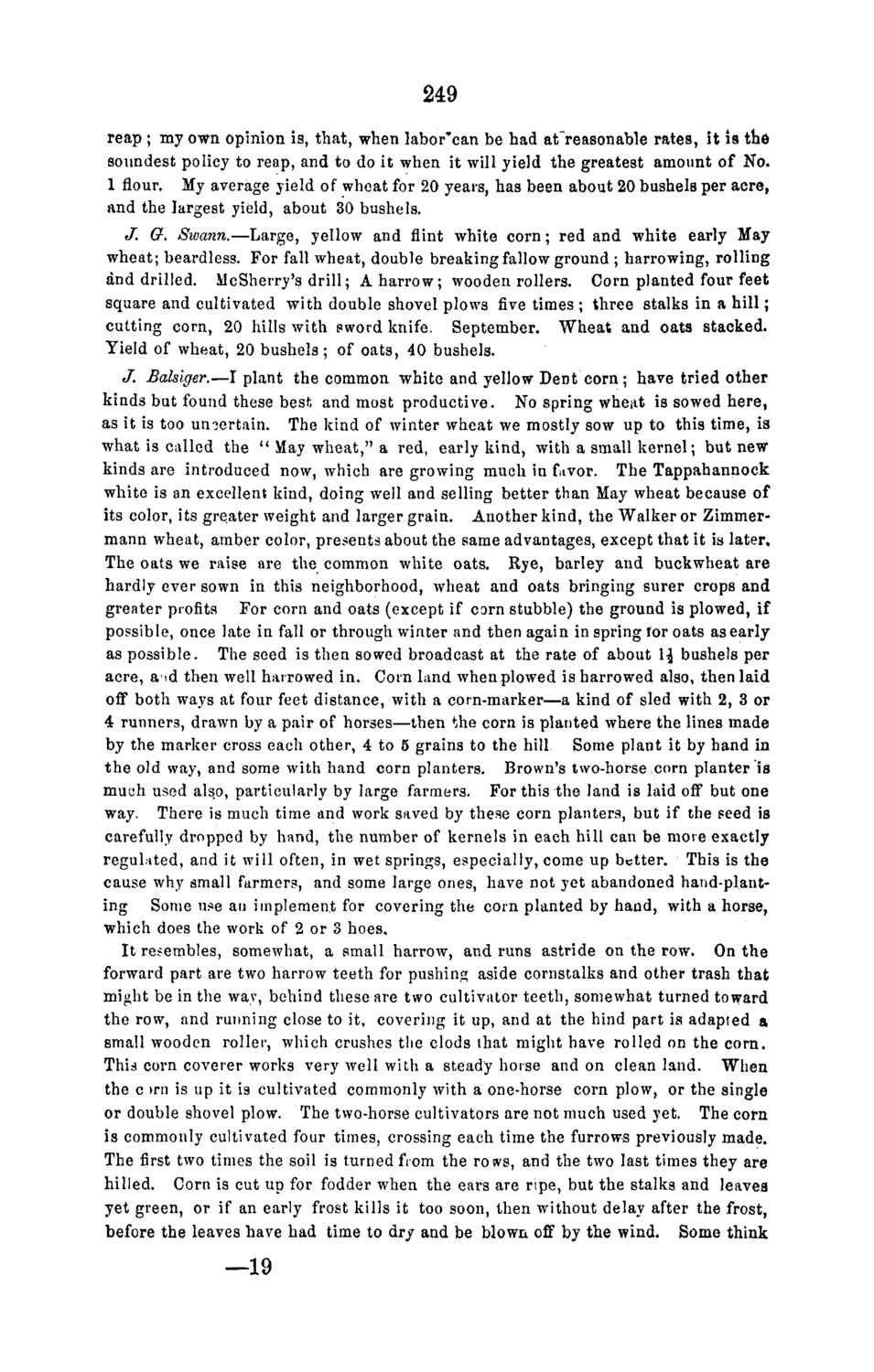| |
| |
Caption: Board of Trustees Minutes - 1868
This is a reduced-resolution page image for fast online browsing.

EXTRACTED TEXT FROM PAGE:
249 reap ; my own opinion is, that, when labor'can be had at"reasonable rates, it la the soundest policy to reap, and to do it when it will yield the greatest amount of No. 1 flour. My average yield of wheat for 20 years, has been about 20 bushels per acre, and the largest yield, about 30 bushels. J. G. Swann.—Large, yellow and flint white corn; red and white early May wheat; beardless. For fall wheat, double breaking fallow ground ; harrowing, rolling and drilled. McSherry's drill; A harrow; wooden rollers. Corn planted four feet square and cultivated with double shovel plows five times ; three stalks in a hill; cutting corn, 20 hills with sword knife. September. Wheat and oats stacked. Yield of wheat, 20 bushels; of oats, 40 bushels. J. Balslger.—I plant the common white and yellow Dent corn; have tried other kinds but found these best and most productive. No spring wheat is sowed here, as it is too uncertain. The kind of winter wheat we mostly sow up to this time, is what is called the " May wheat," a red, early kind, with a small kernel; but new kinds are introduced now, which are growing much in favor. The Tappahannock white is an excellent kind, doing well and selling better than May wheat because of its color, its greater weight and larger grain. Another kind, the Walker or Zimmermann wheat, amber color, presents about the same advantages, except that it is later. The oats we raise are the common white oats. Rye, barley and buckwheat are hardly ever sown in this neighborhood, wheat and oats bringing surer crops and greater profits For corn and oats (except if earn stubble) the ground is plowed, if possible, once late in fall or through winter and then again in spring for oats as early as possible. The seed is then sowed broadcast at the rate of about 1^ bushels per acre, aid then well harrowed in. Corn land when plowed is harrowed also, then laid off both ways at four feet distance, with a corn-marker—a kind of sled with 2, 3 or 4 runners, drawn by a pair of horses—then the corn is planted where the lines made by the marker cross each other, 4 to 5 grains to the hill Some plant it by hand in the old way, and some with hand corn planters. Brown's two-horse corn planter is much used als.o, particularly by large farmers. For this the land is laid off but one way. There is much time and work saved by these corn planters, but if the seed is carefully dropped by hand, the number of kernels in each hill can be more exactly regulated, and it will often, in wet springs, especially, come up better. This is the cause why small farmers, and some large ones, have not yet abandoned hand-planting Some use an implement for covering the corn planted by hand, with a horse, which does the work of 2 or 3 hoes. It resembles, somewhat, a small harrow, and runs astride on the row. On the forward part are two harrow teeth for pushing aside cornstalks and other trash that might be in the way, behind these are two cultivator teeth, somewhat turned toward the row, and running close to it, covering it up, and at the hind part is adapted a small wooden roller, which crushes the clods that might have rolled on the corn. This corn coverer works very well with a steady horse and on clean land. When the c >rn is up it is cultivated commonly with a one-horse corn plow, or the single or double shovel plow. The two-horse cultivators are not much used yet. The corn is commonly cultivated four times, crossing each time the furrows previously made. The first two times the soil is turned from the rows, and the two last times they are hilled. Corn is cut up for fodder when the ears are ripe, but the stalks and leaves yet green, or if an early frost kills it too soon, then without delay after the frost, before the leaves have had time to dry and be blown off by the wind. Some think —19
| |